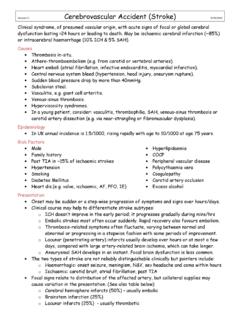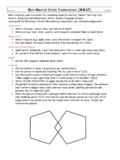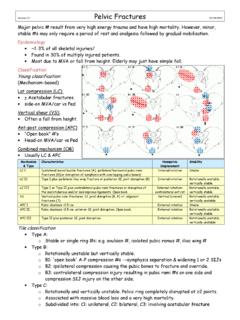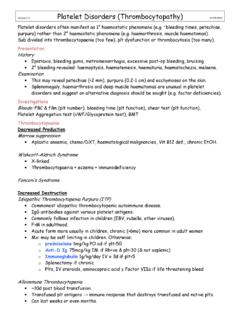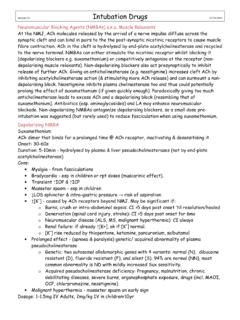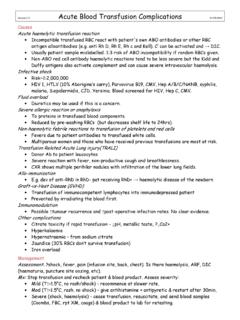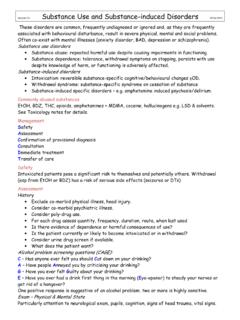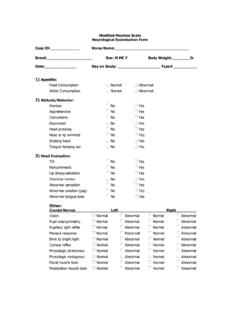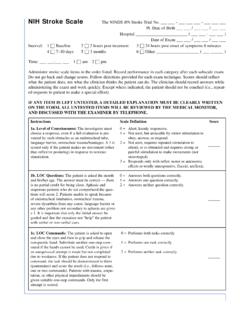Transcription of Upper Limb Neurological Examination - …
1 Upper limb Neurological Examination Prepare patient Introduction Position sitting on side of bed with Upper limbs ( chest) exposed General Inspection General signs: Scars Neurofibromas Skin lesions shagreen patches Motor System Inspection Posture Muscle bulk/wasting/tenderness Abnormal movements Fasciculations (LMN lesion, MND, root compression, peripheral neuropathy, primary myopathy, thyrotoxicosis). Tremor Drift - with arms extended, palms up & eyes closed downward/pronation (UMN. pyramidal/muscle weakness), upwards/pronation (cerebellar), searching/random loss of proprioception). Tone Test at elbow & wrist: Hold patient's elbow & distal fingers. Full ext/flexion of elbow & wrist.
2 Also circumduction at latter. Move at different rates & unpredictably to avoid patient helping. Note hypertonia /rigidity incl lead pipe, cog-wheeling (Parkinson's) or hypotonia (LMN lesion). Power Grades: 0 no movement, 1 flicker of contraction, 2 movement if gravity eliminated, 3 can overcome gravity but not resistance, 4 moderate movement against resistance, 5 normal power. Shoulders: Abduction (C5/6): Upper arms abducted to 90 (elbows fully bent) & press down proximally Adduction (C6/7/8): Upper arms adducted and examiner tries to abduct them. Elbow: Flexion (C5/6) & extension (C7/8) at 90 - examiner holding elbow & wrist Wrists: Cocked down & up for flexion (C6/7) & extension (C7/8) testing.
3 Examiner uses his same wrist to test. Fingers: Extension (C7/8) Examiner pushes down just distal to MCPJs on extended fingers Flexion (C7/8) Squeeze 2 of examiners fingers Abduction (dorsal interossei, C8/T1) examiner tries to close patient's spread fingers by pressing proximally with his two index fingers Adduction (palmar interossei, C8/T1) examiner tries to pull apart closed fingers Ulnar nerve Froment's sign Examiner tries to pull card held between patient's prox thumb & lateral side of index finger. Weakness of thumb adductor muscle if thumb flexes Median nerve Thumb abduction Reflexes Allow tendon hammer to fall freely. Use teeth clenching for reinforcement if necessary.
4 Biceps (C5/6) hit examiner's finger or thumb Triceps (C7/8) support elbow. Supinator (C5/6) hit examiner's fingers Finger jerks (C8) place examiner fingertips over patient's slightly flexed finger tips. Coordination (all cerebellar tests). Finger-nose test: slowly, move target finger. Start with finger. Note intention tremor or past- pointing. Dysdiadochokinesis Rebound Ask patient to rapidly lift arms to 90 in front of him. Test ability to reposition outstretched arms with eyes closed. Sensation Note hemisensory, dermatomal, peripheral nerve or glove distribution of any abnormality. Always test on face or chest first. Pain (& temperature): With pin (use both blunt & sharp ends) test dermatomes lat Upper arm (C5), thumb (median, C6), posterior 1st web space (C6, radial), middle finger (median, c7), little finger (ulnar, C8), proximal medial forearm (T1).
5 Light touch: Dab (don't stroke) with cotton wool test same dermatomes. Less discriminating than pain or vibration. Vibration & proprioception: Test vibration sense with 128Hz tuning fork over DIPJ (test feeling and also when stopped by examiner). If abnormal continue back through wrist, elbow, shoulder for level. Test proprioception at DIPJ, holding sides of finger with patient's eyes closed after an open-eyed demonstration. As before test proximally if abnormal.
